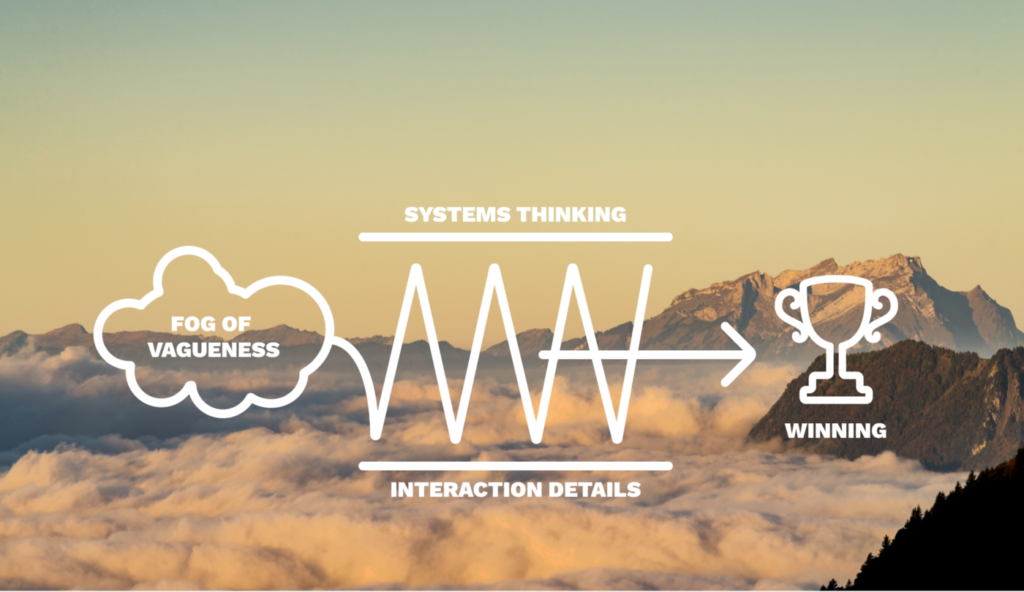First published on Medium on 6th January 2020

Adding design into the consultancy mix has great benefits — solutions are arrived at faster with higher precision, lower risk and with more collaborative buy-in from stakeholders. I spent a lot of last year on projects alongside management consultants merging design processes into projects.
(For this article when I say design I mean something like Design Thinking. My working definition of Design Thinking is collaboratively working with non-designers to apply design processes to solve challenges, particularly in areas where design isn’t traditionally used.)
Design brings focus & clarity
Consultants bring great subject matter expertise, strong business knowledge and excellent stakeholder management skills. But without great care conversations can be frustratingly vague and circular, verbal communication can tend to be imprecise and open to misinterpretations.
Design is a solution-centred craft — we examine problems by exploring different solutions to the problem in hand. We imagine solutions and draw them. A simple sketch is often enough, once it’s drawn the idea can be assessed and improved. Sketches are easily understood by the whole team instantly cutting down on misinterpretation. It brings the conversation away from the hypothetical and onto discussing something concrete. There’s something to push against, to react to, to be challenged and to be agreed upon or rejected. Conversations are focused and efficient.
Oh, and with practice sketches take seconds to create. This is super quick!
But there’s something more subtle that design brings than just visualisations. To be able to imagine details of solutions to a problem designers need to work at the small scale — the details of a user’s interaction with a service; and work at the large scale — the systems and architectures that tie the details together into cohesive whole.
The specific details of a solution shine a light on the systems needed to support it. When you visually articulate details of a customer interaction or user interface you can start to interrogate what would be needed to make it real. Where does this data sit in the system? How does it get there? How is the operating model affected? How much will it cost and can we afford it? etc. Exposing the underlying systems that support a service allow them to be talked about and enables everyone to creatively imagine changing them. This leads to bolder solutions.
Bouncing between these scales creates rapid progress, with an increased understanding of one allowing new ideas to develop about the other. The polarity of thinking that design brings forces the conversation out of the vague middle-ground. There’s less room for fudge.
Design is engaging and shareable
“The visualised user journeys were the key difference in getting stakeholders to agree and buy-in to the vision”
Senior client in the Department of [redacted]
While design processes help a team work together to find better solutions quicker the visualised output makes it a lot easier to share the work. A simple sketch of a solution is easy to show to stakeholders and clients. When we presented solutions to a client as user journey maps instead of an analysis document one reaction was:
“This is basically cheating. You’ve bypassed our normal approvals process where we end up arguing about about the meaning of words. Of course I want all this! Who wouldn’t?”
The discussions with the client was about if the solution was right for them. Design created high value and efficient conversations.
Summary
Adding design processes to consultancy allows projects to:
- Move faster by generating more efficient conversations and creating alignment among the team
- Create better, bolder solutions by focusing on the details and exposing the underlying systems earlier allowing everyone to contribute more creative ideas
- Reduce risk because visualisations reduce miscommunication and create shared understanding of what’s being discussed
- Increase engagement from stakeholders by creating highly engaging assets allowing fast and reliable understanding of the value the solution brings
Work with us! Our innovation agency — What’s Next — helps business leaders challenge, shape and design the future of their products and services. If you have challenges that could benefit from embedding strategic design processes let’s grab a coffee; email me at ed@thisiswhatsnext.co.uk
Footnotes on working together as a blended team
Designers and consultants are largely cut from different cloth, we have different skills, processes and experiences (this is a good thing). And we often end up working to on the same projects solving the same challenges.
Design practice can feel uncomfortable for consultants at first. And in turn designers can behave like misunderstood prima-donnas. The biggest potential sources of friction are the non-linear paths design takes and the changing scales in the design process . When designers are thinking about the systems consultants can worry the designers are trying to ‘solve everything now’ and massively increase scope. When designers are articulating a details consultants worry designers are focusing on the trivial. This leads to designers feeling trivialised and consultants frustrated with progress.
To make the team work effectively the designers must articulate why they are doing what they are doing. And in turn the consultants must trust the designers to run their process.
Designers need to:
- embrace the consultants as part of the creative team and use their deep subject matter knowledge.
- clearly explain the creative process and the value that it brings.
- remember that there are areas where design thinking might not be the right tool, understand where design fits in and around these spaces.
Consultants need to:
- Become comfortable with the design process, particularly the way it moves between large and small.
- Allow time for design to happen with an understanding that the gains aren’t linear.
- Recognise design as first-class critical thinking, not just visualisation